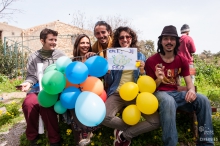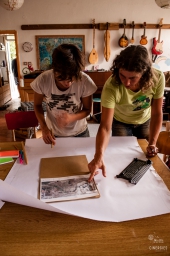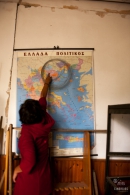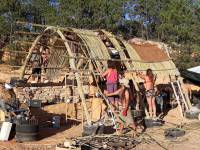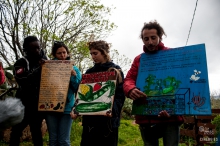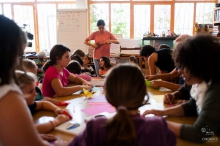Table of Contents
How to design a Heterotopia Tour ?
Defining the target group
For whom should a Heterotopia Tour be designed ?
A Heterotopia Tour can meet the needs of a wide range of people. You may design it for young people (like a youth exchange) as well as for adults who would like to make a change in their life after years of work, or even during their retirement ! Likewise, you can design it for migrants, people without educational background, engineers, students, etc.
The Heterotopia Tour has been designed as an inclusive experience which will impact a person at several levels no matter their age or background.
Therefore, the Tour can be meaningful for both young people who are looking for a first experience of community living or for inspiration for their future, and for adults who would like to take a step back from their daily life, to develop new skills or to undergo a change in their professional path.
As a designer, it means that you will have to decide toward whom you want to gear your Tour.
How to choose the profile and the number of participants?
To answer this question, you need to explore your social and pedagogical goals and to assess your capacities and skills.
We believe that the more diverse the group, the better. Therefore we usually mix people of different ages (from 18 to 60), background, gender, beliefs, physical state (disabled/valid…), etc. but you can proceed in a different way if you believe that you will better reach your goals by gathering people from the same generation or people who are sharing a common situation (for example: people living in an urban suburb, migrants, unemployed people…).
From our perspective, motivation is the most important factor in selecting a participant. We usually look for participants who:
- want to discover inspiring projects, experience community living and a more sustainable life-style;
- are interested in sharing their experience with others after their return;
- are available for the whole duration of the Tour and for the various preparatory and follow-up activities.
Participants should also be able to speak some English. They don’t need to be fluent but should be able to meet other participants and English-speaking partners without being always monitored by trainers or facilitators. The Heterotopia Tour is not meant to be a training course to learn English, but rather to discover alternative ways of living and getting involved into society. Of course, they will improve their English, and everyone will do their best to support them in this process but the use of a foreign language should not prevent them from getting the most out of the Tour.
Apart from your objectives (what you want to do), you need to assess your capabilities (what you can do). Maybe there are some target group(s) you don't have the skills to welcome and support in a proper way, even if you would like to. Have a realistic look at your capacities, so that you can offer a high quality support for the participants .
Regarding the number of participants, we recommend to limit the size of the group to 30 people tops, trainers and facilitators included. Otherwise it will become difficult to feel and operate as a group, to offer room for expression to everybody and to avoid group inertia. But, once again, it is up to you to decide which will be the relevant size of the group, according to your pedagogical objectives, to your logistical abilities and to your team's skills and size.
Choosing the venue(s): Where should you implement a Tour ?
The location(s) of the Tour (there are usually several venues into one Tour) are a key issue. Both the venues themselves and the willingness of the people living there to welcome a group and share their space, time and knowledge will immediately impact the participants, either in a positive or in a negative way. Therefore, we strongly recommend you to:
Analyze the current context and assess what resources are available
Before choosing a venue, go and visit the area! Look at the landscape, feel the local atmosphere, try to understand the context by meeting the people living and getting involved in the area.
It is important for you to understand the local trends, the way people live, the economic, social, cultural and political background in order to understand if this area will be a fertile ground for you to grow your Tour (or not).
You may want to look into what room for social economy and active citizenship there is in the area. Is there a local dynamic towards social economy? and therefore a set of projects you can easily visit during a Tour? And are those social / eco-friendly projects in a wide range of fields (so that you can diversify the workshops and visits) or are they all dealing with the same topic / field of activity (for example farming)?
Clarify the needs and expectations of your potential partners
If you believe that the area has enough assets to organize a Tour, explore the needs and expectations of your potential partners. Who are the people who would like to join you as partners? and who among them would like to welcome the group on the site of their project?
Look for projects who will be strong allies, on which you can rely because their members really want to support you. They will introduce you to and into the area they live in, and bring you into a deep and intense experience.
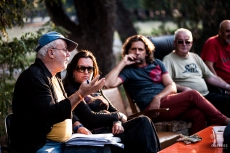 We advice you to organize at least one meeting where all the potential partners can meet and voice their motives, ideas and concerns, why your project meets their interest and what they would like to offer to you.
We advice you to organize at least one meeting where all the potential partners can meet and voice their motives, ideas and concerns, why your project meets their interest and what they would like to offer to you.
Then, pay another visit to the ones you will eventually work with in order to clarify their needs and expectations as well as yours. If you agree on the “WHYs” and “HOWs” you want to be partners, you can go ahead in your search for a location to set your camp!
Make sure the venue can meet the group's basic needs
Last but not least, you need to check if the venue(s) can meet the needs of the group from a practical perspective. We recommend you to pay attention to:
- the space available : is it vast enough so the participants don't feel squeezed into a small place (but have the room they need to feel comfortable)?
- the topography : is it flat enough to pitch many tents?
- the shade : is there one or several places with shade, so the participants can hide when the sun hits hard?
- the soil quality: is there grass? We won't be growing vegetables, yet a rockless patch of grass is often appreciated in a campsite.
- the availability of a shelter, in case of rain or storm
- an easy water access, because human beings tend to need it for many purposes (drinking, cleaning…)
- an access to electricity, since our electronic devices might require some, from time to time
- a road access: being far from any semblance of civilization can have its benefits, but keep in mind it will make any logistical arrangements trickier, and the participants might not be used to being so isolated from human activity.
If the venue(s) meets your requirements, you can move on to the next stage in organizing your Tour : designing the different steps, duration, activity schedule, etc.
Taking care of the partnerships
A Heterotopia Tour can be implemented both at international and at local/regional level.
In each case, you will have to establish solid partnerships for the implementation: at local level, you will have to collaborate with your host, with initiatives to visit, with external facilitators, local producers etc. If you decide to keep the international aspect of the Tour (which we really recommend), you will collaborate with partners who will select, prepare and accompany the participants; they will be an active part of the project in designing, implementing and evaluating the Tour. You will have a team who aims and works towards shared goals and results.
Local partners
The choice of local partners should look beyond the Tour’s lifetime: ideally, they shouldn’t be only temporary members of a single project, but people with whom you can build and create something on your territory on the long run.
Frequent meetings will be needed with your local partners to organize the hosting aspects and to learn about the resources and equipment available. Before the participants arrive, you'll have to get familiar with how the structure works, which are the already existing rules, how flexible those rules are, what are the safety issues etc. Get used with your partners’ schedule and adapt: implement the Tour when they can dedicate their full attention to the project. Don’t be afraid to check all necessities and to ask clarifications – it is better to ask than to discover things during the Tour!
Arrange meetings in the locations that will host the activities to better understand the morphology of the place. Further communication can take place through phone calls or online tools, but to establish a solid relationship based on common objectives, you have to invest your time in in-person meetings. Partners who believe in your values and objectives will be willing to support you throughout the Tour and have a solution-based attitude.
Involve local partners in monitoring and evaluating the activities: organize frequent meetings (at least every 2-3 days during the Tour) and discuss how they feel about the group staying at their place, how logistics are working, what could be improved, how the group feels about the place. This collaborative attitude will make them feel that they are part of the process and that their needs are also considered and respected.
International partners
To establish an efficient international partnership based on common values and mutual respect, you have to overcome some difficulties: physical distance, misunderstandings caused by cultural and language differences, conflicts resulting from different workloads and working methods, etc. For a smooth implementation, we propose you to:
- Reach common understanding on keywords and terminology: Does “learning”, “inclusion”, “cooperation”, “responsibility” etc. mean the same for everyone?
- Get to know your partners’ working (and learning) style and methodologies: Attend a training course together, facilitate a small session or a workshop together, experiment your team-work and decision making on a small scale.
- Divide responsibilities equally and fairly: Make sure everyone is an active participant in the process, not just someone who benefits from it. Assign tasks based on the expertise of partners first, then on the workload each task represent. Remember to balance out the economic or other type of compensation with the responsibility taken and the work done. Put all these in a written agreement.
- Share among you the most convenient IT tools: Remember that each organization uses different management and communication tools, so decide together with your partners which one you would like to use and how. Use collaborative work spaces to share data, information, co-write and co-edit, create an agenda with online meetings.
- Review the expectations of each partner: Make sure you are on the same board, partners are motivated, committed and in case, willing to make sacrifices to achieve the project's objectives.
- Share information on everything that affects the Tour: An honest and transparent communication will help you find solutions in case of difficulties. Support international partners to obtain all relevant information: we suggest you to organize a preparatory visit before the Tour, but if it is not possible, provide an InfoKit with detailed information and visual support (e.g. photos of the venue).
- Monitor and evaluate together: During the Tour, organize daily meetings if necessary, involve partners in the decision making process and ask their opinion about the changes that you plan to implement with the group, based on the daily feedback of the participants. Since they know better the profile and needs of their participants, they can help you to better refine the activities and logistics.
- Be compassionate and support each other: Keep in mind that each partner has made great efforts to successfully implement the Tour – in moments of tension, conflicts or frustration remember to be supportive and have a solution-based attitude.
Defining the steps and the duration of the Tour
Make time your ally
Time is a keystone in whatever trip; it will be a fundamental factor in your Heterotopia Tour.
No matter the group, the venue(s) or the program of the Tour, we observed that the group always goes through the following stages:
- the first step is about discovering the others, adapting to new living conditions and getting familiar with them;
- the second step is usually a more troubled stage: the participants are now familiar enough with the basics of the Tour (living conditions, pace, activities…) but some aspects of it don't suit them. They become more critic, they express some discomfort or wishes for some things to change regarding community living, facilitation, the program, the pace of the Tour or the living conditions. Tensions might emerge as well as some form of tiredness. The group is at a crossroad: either it keeps going as it used to until now, without addressing concerns and critics, or it transforms and adopts new rules and regulations;
- The content of the third and last step will depend on the decision that was made on the previous step: there are two possibilities.
If decisions have been taken to address the critics of the participants and the group has put solutions into practice, the group will most probably move forward: it will continue to grow and will express its full potential;
If the “status quo” was adopted, the trends you observed in the previous step will take hold and the group will experience some degree of stagnation, waiting for the Tour to reach its end.
The duration of each stage can vary a bit, but they are usually around 5 to 7 days. We strongly recommend to keep them in mind when designing the Tour in order to support the group on its journey. Making time your ally will enable you to reach your pedagogical objectives.
 Whatever your choice regarding the number of steps and venues, we believe a Heterotopia Tour should last at least 15 days to allow both the participants and the group to evolve, learn and grow.
Whatever your choice regarding the number of steps and venues, we believe a Heterotopia Tour should last at least 15 days to allow both the participants and the group to evolve, learn and grow.
A shorter Tour won't provide enough time for the metamorphosis to take place. Participants might choose a“status quo” situation over addressing the issues and tensions within the group -or towards the organization team-, knowing that they will be back home shortly.
A longer Tour will be more challenging but we believe it has much more potential because people won't be able to endure the many days left from the Tour without expressing what bothers them and what they would like to change. They will be compelled to voice their needs out loud and the group will respond to their critics and grow, look for a new balance, new rules, another way to be together (usually this critical moment happens after 6-8 days).
Thanks to the long duration of the Tour, the group will still have time after the crossroad to experiment this new way to organize, and to assess it (usually at the end of the second week). The final part of the Tour will begin then, when the group will experiment a third way to act and be. It will be time for the participants to try on what they have learned during the two previous stages and to challenge themselves, both as individuals and as a group.
For this reason, we advocate 3 weeks long Tours, and not shorter than 15 days (to allow 3 steps of 5 days each, approximately).
Designing the route
While selecting the venues you will visit, you should keep in mind the aforementioned stages the group will go through.
It is possible to stay in the same place all the Tour long, but we recommend to change the venue after each main stage. This physical move will symbolically go along the growth and the metamorphosis of the group.
The choice of the different venues should take several parameters into consideration:
- the resources available: which are the initiatives you can visit in the area? What kind of activities can you imagine with each of them?
- the needs of the group: did the participants get the chance to get to know each other? If they have, do they wish to discover people and projects from the surroundings? Does the group feel like it needs a rest, or on the contrary the participants can't wait to take part in more intense activities?
- the practical consequences of your choices. Be aware that the further your destinations, the longer the trip, the fewer time available and the bigger your ecological footprint. Therefore, be pragmatic and optimize the route so that you can reduce the transportation and focus on what you want your Tour to be about.
Take a map and draw the itinerary you've chosen for ideal Tour. You can now contact local partners and design the program of your Tour together.
Selecting the activities and the workframe
Offer a glimpse of different society thanks to an eclectic but coherent program
The Heterotopia Tour is based on a holistic approach. It connects social, economic and environmental aspects and demonstrates that the problems we are facing are interconnected and need to be addressed simultaneously. The Tour enables participants to recognize themselves as part of the ecosystem and offers a perspective on how to handle complex systems.
We encourage you to design it in such a way that it will:
- highlight the ability of “ordinary citizens“ to successfully address the challenges they are facing;
- encourage people to adopt a positive attitude towards adversity, by showing that there are solutions to any problem;
- give people confidence in what is going on, and in their own ability to take action and embody the change they want for themselves and for society.
In our opinion, a Heterotopia Tour should offer a non-conventional approach to address the topics of social entrepreneurship, ecologic awareness and active citizenship.
By associating theory and practice, interviews with social entrepreneurs, practical activities in various fields, community living and an eco-friendly lifestyle, the purpose is to give to the participants the opportunity to develop their self-confidence, entrepreneurial abilities and soft skills all at the same time.
Meeting social entrepreneurs will relieve their fears regarding entrepreneurship, while giving them pragmatic ideas about how to proceed when taking action. Meanwhile, living within a group/community will encourage them to explore the meaning of “responsibility” and “solidarity” towards others, to expose themselves to other realities, cultures and opinions. The day-to-day constraints during the journey (cf. chapter 5.1 “Logistics and Practical arrangements” and 5.2 “Eco-living and ecological footprint”) will eventually help them to get out from their usual routine, discover ecological issues and move onto a more sustainable way of life thanks to their increasing awareness and to the practical skills they will develop.
We believe that the more eclectic the Tour, the better. The purpose of Heterotopia isn't to train the participants in depth on a single topic, but rather to offer a perspective to the huge diversity of meaningful actions which contribute to a more sustainable and fair society. For this reason, we recommend you to question different contexts during your Tour (urban / rural, dynamic / economically depressed, central / peripheral) as well as different disciplines / fields / sectors of activity. That way you can show that sustainability can be addressed in any kind of environment and regardless of the resources available, as long as people have the will to change, get organized and make efforts to reach their goals and face unsatisfying situations.
A pedagogical frame based on non-formal education
The Heterotopia Tour is fully based on the methodology of non-formal education. Each and every activity the way we introduce it is tailor-made for the group. It doesn't prevent us from using formal exercises -such as presentations- if we feel it is well suited to the current goal. As a non-formal educational program, the Tour is designed to reach the objectives of the learners, providing tools to overcome personal difficulties and enable them to reach their full potential.
We define non-formal education with the following principles:
- Learner-based approach – personal learning goals are at the core of the program: our goal is to help improve the skills, knowledge and know-hows of each participant according to the objectives they set for themselves. Facilitators need to be aware of the socio-cultural and educational background of the participants and about any special needs they might disclose. The design of the activities will take the current knowledge of the participants into account, such as language skills, practical skills, prior knowledge on the topics of the project etc. The information you will gather during the preparation phase will enable you to adapt your program to your participants and to put the “learner-based approach” into practice.
- Objective based educational program – All of the activities should contribute to reach the general and specific objectives of the educational program, while achieving the personal learning objectives of the participants. Each activity should include a clear educational objective. When designing the Tour, always keep in mind what your objectives are and what a Heterotopia Tour is about (cf. Chapter 1: “What is a Heterotopia Tour?”)
- Continuous monitoring of the learning achievements – Facilitators and participants are co-responsible for monitoring the learning process; they should evaluate the progress of the learning journey, with the matching objectives in the educational program. The monitoring moments should take place frequently enough so the group gets the chance to alter the program or the methods used so they fit to the needs that will emerge along the Tour. Ongoing monitoring helps identify -in a timely fashion- the factors that stall the participants in their learning, and enables the group to create a better learning environment by navigating through those factors. (You can read more on this topic in the chapter 5.6 “Monitoring and evaluation”).
- Flexible program – The educational program should be flexible enough to acknowledge the needs identified during monitoring moments (cf.Chapter 5.3 “Activities / Schedule”). With the changes in the activities and methods we aim to create better circumstances for achieving the objectives.
- Responsible learning and voluntary participation – In a non-formal educational program, the participation of learners is voluntary. This means that they have a personal reason and motivation to participate and that they take responsibility for their own learning; they understand that their level of participation and contribution influences the outcomes of the learning program the same way as the facilitation does. That's why the quality of the selection and preparation of the participants is crucial (cf. Chapter 4. “How to prepare and select the participants of the Tour”).
- Horizontal facilitation approach – The role of the facilitators is to create the right circumstances and trigger positive dynamics that can result in the highest learning outcomes. Their role is not to spread knowledge, but to facilitate the co-creation of collective knowledge, starting from the resources of the group itself, complementing them with inputs from external sources. (You can read more about the facilitation approach under Chapter 5.5 “Facilitation”.)
A delicate balance between theory and practice
To finish this chapter, we would like to highlight the fact that, for us, the essence of non-formal education is to put what we’ve learned in theory into practice, and vice versa – learn things by doing them and then organize the knowledge gained during the experience into a structured whole. Learning must take place within a cycle of discovery, creation, action, reflection and application.
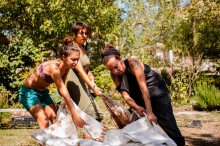 A wide variety of methods exist to match various learning styles and needs. The more you diversify the pedagogical approaches, the more you enable each participant to discover their preferred learning practices and make the most of the learning opportunities of the Tour. Therefore, when it comes down to choosing activities, we recommend that you pay attention to the balance between theory and practice.
A wide variety of methods exist to match various learning styles and needs. The more you diversify the pedagogical approaches, the more you enable each participant to discover their preferred learning practices and make the most of the learning opportunities of the Tour. Therefore, when it comes down to choosing activities, we recommend that you pay attention to the balance between theory and practice.
By “theory” we don’t mean plain lessons, but activities that have an informative, analytical approach. Theoretical activities should still be interactive and participative. They will help the participants to understand the ethical, political or scientific framework of the project / technique / activity they are introduced to.
In addition, the integration of practical (manual) activities in the program will help to:
- Improve social connections and group dynamics – participants with language difficulties better engage in practical activities which reduce the risk of feeling excluded and strengthen the relationship with other participants
- Keep the level of commitment high – a practical activity following a more theoretical one boosts the energy level of the group and prevents the feeling of being overloaded with information
- Make it easier for participants to contribute – participants who are less talkative can have their space to contribute to the activity
- Deal with the theory – practical activities help to process information and can represent mental challenges that lead to resolution of problems
- Reduce frustration and bring a sense of satisfaction – the creation of something solid, the participation in the whole process from the beginning to the end helps participants to boost their self-esteem, to feel effective and to develop their sense of initiatives; manual activities also contribute to mental health, well-being and stress management.
To help the positive flow of energy, you can also vary:
- the posture of participants: alternate activities where participants sit, stand, move or stay still;
- the venue: change learning environment, switching from indoors to outdoors, organizing field trips to new locations, etc.
- the size of the work groups: vary between individual tasks, work in small groups, and big groups.
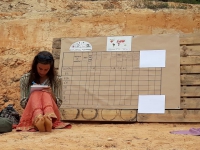 The efficiency in learning is linked to how the learner feels in their surroundings: changing position, location, sound atmosphere will help the mental switch between topics and offer a conclusion to a session before starting a new one.
The efficiency in learning is linked to how the learner feels in their surroundings: changing position, location, sound atmosphere will help the mental switch between topics and offer a conclusion to a session before starting a new one.
To close the loop, don’t forget that each activity should be followed by a time for reflection and processing. Linking the experience with prior knowledge and with the objectives of the program will put some meaning into it, put it into perspective.
